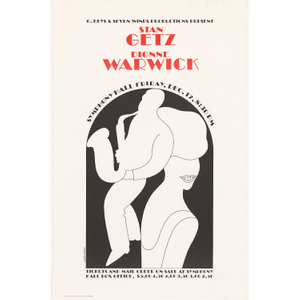Description
A leading exponent and popularizer of cool jazz in the 1950s, tenor saxophonist Stan Getz (center) initially played with some of the swing era’s top bands, including those led by Jack Teagarden, Stan Kenton, and Benny Goodman. Getz began distancing himself from swing in the late 1940s, developing a saxophone quartet within Woody Herman’s Second Herd band that gave the larger ensemble its distinctive sound. After his solos on “Early Autumn” (1948) gained him a national following, Getz created his own group in 1949, borrowing members of Charlie Parker’s rhythm section such as double bassist Tommy Potter (left) and pianist Al Haig (right) when they were not working with Parker. A superbly melodic soloist, Getz embraced an “artfully relaxed” performance style that epitomized cool jazz. When enthusiasm for that genre waned in the 1960s, he reenergized his career by initiating a fusion of American jazz and Brazilian bossa nova.Uno de los principales exponentes y promotores del cool jazz en la década de 1950 fue el saxofonista tenor Stan Getz (centro). En sus comienzos tocó con importantes bandas de la era del swing, entre ellas las de Jack Teagarden, Stan Kenton y Benny Goodman. No obstante, para fines de la década de 1940 empezó a distanciarse del swing y desarrolló un cuarteto de saxofones dentro de la banda Second Herd, de Woody Herman, que dio a esta su sonido distintivo. Cuando sus solos en “Early Autumn” (1948) le ganaron una fanaticada a nivel nacional, Getz fundó su propio grupo (1949) con...
Image
Selenium Toned Gelatin Silver Print
National Portrait Gallery, Smithsonian Institution
Record Contributed By
National Portrait GalleryRecord Harvested From
Smithsonian InstitutionKeywords
- Allan Warren Haig
- Bass
- Charles Thomas Potter
- Composer
- Design
- Entertainers
- Equipment
- Getz, Stan
- Haig, Allan Warren
- Horn
- Interior
- Interior Decoration
- Jazz
- Leonard, Herman
- Male
- Men
- Microphone
- Music
- Musical Instrument
- Musical Instruments
- Musician
- Musicians
- Performer
- Performing Arts
- Pianist
- Piano
- Pianos
- Portrait
- Portraits
- Potter, Charles Thomas
- Saxophone
- Saxophonist
- Sound Devices
- Stan Getz





















